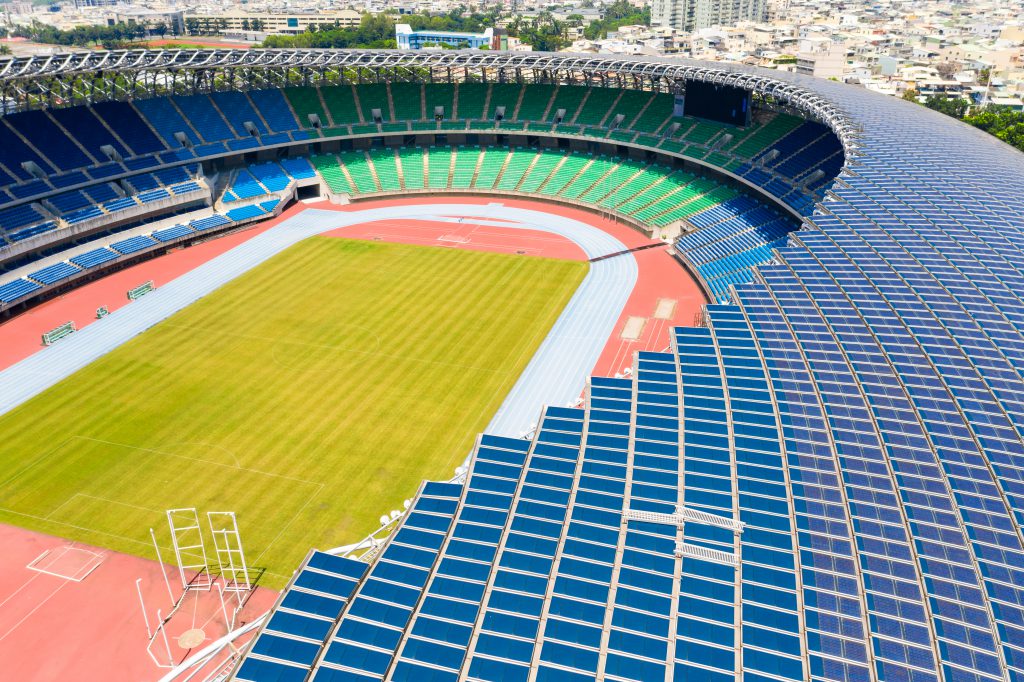Investment in low-carbon innovation, green bonds and carbon pricing could speed up sport’s sustainable revolution, says Conor Foley
There is no escaping the fact that the amount of investment required for sport to achieve net-zero emissions is enormous. It is only natural to ask, where will all the money come from?
Financing sustainability in sport may appear a daunting task but it is worth pointing out that sport is not alone. Value chains across all sectors must transform; lessons will be learned and solutions will be found.
The investment needed should also be examined in the context of evolving financial and regulatory mechanisms that are making sustainability a must. Because of this changing landscape, investment is flowing directly into sustainable products, shifting the dynamic of the sustainability cost-benefit equation and making it a profitable decision for all organisations, including those involved in sport.
One of the financial market’s main purposes is to ensure that capital, whether that be debt or equity, will flow to where it’s needed. The problem however has been that for too long capital for environmental purposes was not deemed urgent by the financial system.
However, just as it seems like some football teams need to go 1-0 down to bring out their best, there is finally a growing consensus in the financial community that capital flows and lending must facilitate environmental transitions.
It’s a fact that sustainability criteria are increasingly now less of an option and more a societal and regulatory requirement.
A combination of responsible investment advocates, such as the United Nations Principles for Responsible Investment, and pressure from society and clients, has led to a fundamental change in investment markets. Sustainable investment principles have moved from niche to the mainstream amid growing evidence of direct financial benefits such as enhanced returns and better managed risks.
For sport to achieve its sustainability goals both direct and indirect capital flows are relevant. Direct flows are the required investment in sports’ own infrastructure and operational models, but before we delve into the sources of direct financing, it’s important to first recognise that sport’s transition is also a function of indirect flows; sport sustainability will benefit indirectly from investment elsewhere, in non-sport sustainable technology companies that will provide the environmentally friendly products and services that sport will use.
Sustainable funds
In 2020, investment in sustainable funds, which are made up of companies aiming to help the environment and promote social good, reached $1 trillion, according to financial data company Morningstar. In addition, billions have also privately flowed into similar types of sustainable technology companies at early stages in their life cycle from venture capital firms and ‘seed’ or ‘angel’ investors.
A global survey conducted by the deVere Group in 2020 found that for 77% of ‘millennial’ investors (i.e. those born between 1981 and 1996) environmental, social and governance issues are their main priority when evaluating portfolio opportunities.
Yes, the most profitable investment opportunity in the room is most desirable, but an investment opportunity must be sustainable to get in the door in the first place. These investors are privately receiving wealth transfers from ‘baby boomers’ and professionally moving up into decision-making roles and making portfolio decisions for pension funds, endowments and sovereign wealth funds.
Flows of investment into a product or service will, along with experience, usually lead to efficiency gains and cost reductions of that same product or service. We have seen this happen with everyday technologies such as televisions and personal computers. The same ‘learning effects’ are happening, and will continue to happen, with sustainable technologies.
When a sport organisation – or any organisation for that matter – is allocating its finite budget across projects it is appropriate to compare the cost with the benefit that will accrue.
The cost reductions and efficiency gains resulting from widespread investment in sustainable technologies across the economy is making the sustainability cost-benefit equation facing a sport organisation shift in favour of sustainable action. Renewable energy and batteries are just two examples relevant to sport.
It’s true to say that stadiums are high energy users. The Johan Cruyff Arena in Amsterdam, San Francisco’s 49ers Levi’s Stadium and the Taiwan National Stadium (pictured below) are just a few of the many examples of sport arenas with on-site solar powered energy sources.

Solar panels are a prime example of efficiency gains resulting from continued investment, research and development. According to the EnergySage Solar Market Place, the cost of a solar panel installation in the US was $8.50 per watt in 2009, and now averages between $2.40-$3.22 per watt.
Sport is also transport-intensive. Sport organisations can directly influence the transport emissions of their participants and staff, and encourage environmentally conscious travel for spectators. The Seattle Seahawks, Borussia Dortmund and Forest Green Rovers are just three examples of sports teams that have electric vehicle charging stations at their stadiums. BloombergNEF reported that the price of a Lithium-ion battery pack, a key technology for electric vehicles, dropped 88% from 2010 to 2020.
The advancement of the circular economy has a particular relevance to sport given the level of waste associated with match days and the amount of material required for stadium construction. Blackrock, one of the largest investment managers in the world, launched a circular economy fund in October 2019 and has since raised more than $1.4 billion, investing in companies that design products that will facilitate the reuse, refurbishment and recycling of materials and products for as long as possible.
It’s not all one way. Investment in technology is also happening within sport that will benefit wider society. Formula 1 has pledged – spectator travel aside – to be zero carbon by 2030. A part of its plan is using engineering know-how to work with the automotive industry to create the world’s first net-zero carbon hybrid internal combustion engine.
Green bond market
The $1 trillion green bond market is also relevant to the discussion. Bonds are similar to bank loans in that they are methods for governments and institutions to borrow money, but unlike loans bonds can be traded on markets over the course of their life so their value can go up and down.
Green bonds are where the funds being raised are to exclusively finance all types of environmentally sustainable projects and will for example play a large role in mobilising cost-efficient, long-term financing for the UN’s Sustainable Development Goals and Nationally Determined Contributions associated with the Paris Agreement.
The benefit of issuing a green bond over a traditional one is that its green label conveys a credible signal of commitment to sustainability and can attract investors that are mindful of protecting the environment. Examples of projects undertaken by Green Bond issuers include Bank of America’s investment in numerous solar and wind farms, Toyota’s funding of vehicles that meet specific clean air criteria and Volkswagen’s contributions to e-charging infrastructure.
‘Green buildings’ are a category that can be selected for the use of proceeds from a green bond. In 2015 Arizona State University issued $180 million of green bonds, backed by the University’s future revenues to refinance LEED Gold certified buildings for the University. It is conceivable that a sport organisation, either in its own right or in partnership with a public or private entity, could finance or refinance a sustainable stadium by issuing a green bond.
Bonds are already a common source of funding for stadiums in the US. The US government allows state and local governments to issue tax exempt bonds to raise the finance to pay for sports facilities which reduces the financing cost. A study titled The Economic Impact of Sports Facilities, Teams and Mega -Events claimed that between 1990 and 2010, 70% of the funding of new sport facilities in the US came from public sources, mostly through bond issues.
Banks are the gatekeepers of sustainability, but traditionally large-scale international banks have been slow-moving institutions. But the competition caused by financial technology (fintech) firms, and neo banks disrupting the industry, is now causing even the most traditional lending institutions to be more flexible and speed up the process around launching new products and lending facilities such as green loans for example.
Green loans are discounted loans to organisations that want to implement environmentally sustainable economic activities. A ‘Sustainability-Linked Loan’ is where the proceeds of the loan are used for any purpose but the pricing of the loan is based on the borrower’s sustainability achievements.
To tackle climate change governments and regulators globally are trying to instill regulation that will embed sustainability into the financial system. Recent papers from the European Central Bank and European Banking Authority have discussed increasing Environmental, Social and Governance related responsibilities for banks. These papers have recommended embedding sustainability into banks business strategy, governance, risk management and credit assessment. Regulation like this will accelerate sustainability to the core of the wider economy and help fund the green economy.
From a sporting organisation’s point of view, it may be the case that to receive debt financing in the future, sustainability criteria will have to be met.
Carbon pricing
There is a stronger business case for the reduction of emissions if there is a negative financial consequence to being an emitter. Carbon pricing is the matching of the true external costs of greenhouse gas emissions to their sources through a price and governments will tackle climate change by taxing emitters using these prices under the “polluter pays” principle. The proceeds collected can support those not equipped to meet the sustainability challenge via grants and subsidies.
The EU Emissions Trading System (ETS) currently prices carbon at €39.07 per tonne. The 2020 Rapid Transition Alliance report Playing against the clock: Global sport, the climate emergency and the case for rapid change by David Goldblatt estimated that global sport contributes 300-350 million tonnes of carbon a year putting it as an equivalent producer as Spain or Poland. At the current EU ETS price of carbon, this equates to a monetary cost of €11.8-€13.8 billion a year.
Sport organisations can get ahead of the curve and put a monetary value on their own greenhouse gas emissions with an internal carbon price as a strategy to encourage investment in sustainable technologies and prepare for future climate-related policies and regulations.
In addition to banking and capital markets, there are of course various financial mechanisms that provide grants and subsidies. UEFA has recently pledged support for the EU’s European Green Deal. The investment arm of the initiative called the Sustainable Europe Investment Plan (SEIP), will mobilise at least €1 trillion in sustainable investments in member counties, across all economic sectors, over the next ten years.
Within sport, domestic and international grant and subsidy schemes will likely place more and more emphasis on sustainable projects. Funding is not likely to be the only dimension of sport tied to sustainability. It could be the case that participation in sport events become tied to the delivery of sustainability targets.
A very topical question is whether Covid and its related measures and recovery packages are diverting funds away from sustainability?
Despite many promises from governments that Covid is an opportunity to “build back better” the most recent edition of the Green Stimulus Index, as of February 2021, shows that rescue packages from governments to date “have largely failed to harness this opportunity, though a select few are rising to meet the challenge such as Canada, Western Europe and some Nordic countries.”
Across announcements to date, according to the Green Stimulus Index, a clear set of tools have emerged to boost the economy in the short- and long-term, while also accelerating the transition to a more sustainable future:
– Corporate bailouts with green strings attached
– Investment in nature-based solutions, such as tropical rainforest conservation and sustainable agriculture
– Loans and grants for green investments
– Subsidies or tax reductions for green products, and the removal of subsidies for polluters
– Green R&D subsidies
– Reinforcing environmental regulation
Innovation programmes
Outside of the main channels of banks, capital markets, and government grants and subsidies, there are also alternative routes for environmental financing for sport. The Greenfoot Programme of the European Football Development Network is supported by UEFA. It is an example of an innovative financial solution made possible by the European Union’s Horizon 2020 research and innovation programme. Greenfoot aims to facilitate the financing of renovating football stadiums, training facilities and office space via community financing or crowdfunding. The Azerbaijan, Irish and French Football Federations are among the sport bodies involved in the project.
Energy Savings Insurance is designed to address investment barriers to energy efficiency upgrades for small and medium organisations and pays out if energy savings do not actually materialise. From initial piloting in Mexico and Colombia this type of insurance is currently being deployed in three European countries, Italy, Portugal and Spain via an Agency for Sustainable Energy (BASE) programme with funding from the European Commission.
Individual philanthropists will also participate in financing the transition to a low carbon world. For example Jeff Bezos, CEO of Amazon, made a commitment in 2020 to give away $10 billion to fight climate change.
Making any investment decision involves weighing the costs against the benefits. For a sporting organisation contemplating sustainable action the following are relevant:
– Sustainability is increasingly becoming a requirement as opposed to an option or a choice. State funding allocations to sport will likely place more and more emphasis on sustainable projects. It could also be the case that in the future, participation in sport events is tied to the delivery of sustainability targets.
– The financial costs of installing environmental products and services are decreasing. Continued investment across all spectrums of finance, from private sources to public markets are enabling green power, green transportation, pollution controls, recycling, waste reduction, and organics, to be more efficient and cost-effective for end-users.
– Once initial capital expenditures have been made, lower ongoing water, maintenance, insurance and energy costs can be expected thereafter.
– The cost of not acting will increase. ‘Polluter pays’ consequences of being an emitter will allow a truer measurement of those costs.
There are many forms of potential financing for sport sustainability to undertake environmentally friendly projects, but there is of course a long way to go and a lot of work to be done within the financial community to ensure such flows keep increasing to meet the sustainability challenge of not just sport but all activities.
Although Covid is being referred to as an opportunity to “build back better” it is disappointing that many governments have chosen not to use economic rescue packages to enhance nature or tackle climate change to a greater degree than we have seen. In dealing with one crisis, we cannot be distracted and forget about the other.
Given that sport has been among the worst, if not the worst, sectors in terms of negative economic impact caused by Covid and its related measures, it is understandable that many sport organisations might feel that they cannot afford climate change adaptation and mitigation measures currently. But given the magnitude of the issue, and the long-term financial, societal, and environmental benefits that can arise from action now, can sport afford not to?
Conor Foley is a chartered financial analyst for KB Associates and sport finance writer










Leave a Comment
Your email address will not be published. Required fields are marked with *